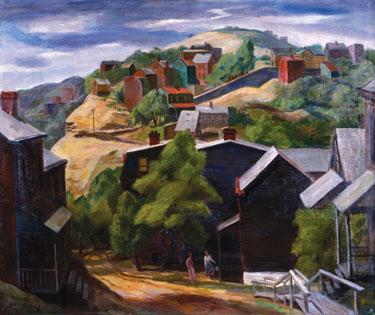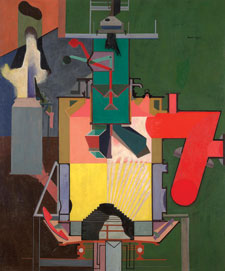 |
||||
Above left: Elizabeth Rothwell, American, c. 1877-1946; The Chinese Coat (detail), 1910; Lent by Graham Shearing.
|
The Popular Salon of the People: Then and Now
Photo: Tom Altany |
|||
 |
Lila B. Hetzel, American, 1873-1967; Lit Cigarette, 1948;Lent by John Schulman and Emily Hetzel. |
Today, it’s a trio of females—curator Vicky Clark and artists and Annual co-chairs Adrienne Heinrich and Susan Sparks—who are making an important contribution to the history of art in Pittsburgh and offering a glimpse into its future by way of the AAP retrospective and the 97th Annual.
The Pulse of a Place
The relationship between the local, national, and international art scene remains complex, says current AAP President Pati Beachley. But the retrospective definitely brings AAP into a national focus.
“We have long heralded the importance of regional writers in capturing the flavor and texture of a locale, and crafts people are expected to embody the continuing traditions unique to this area,” says Beachley. “This, too, is the value of the local, of the regional, of Associated Artists of Pittsburgh. …Cities and towns are beginning to recognize that if artists are not present to actualize the pulse of a place then that place is historically and culturally off the map.”
Everett Warner, a member of the painting and design department at Carnegie Tech and a 10-year member of AAP, felt the same as early as 1934, when he wrote this about the Annual in the pages of Carnegie magazine: “Yes, it is just a local show. But these local shows are held here and elsewhere and are the living springs which feed the main current of national art. We are playing a definite part in the art life of this country, and we are quite as necessary to New York as New York is to us.” To this point, it’s rare in a city the size of Pittsburgh to have two large-scale exhibitions, the Annual and the Carnegie International, reach a centennial, says Clark.
In many respects—for funding and exhibition space in particular—in Pittsburgh the Annual continues to compete, and survive, alongside the bigger, brighter Carnegie International. And prior to the late 1980s, when the International began presenting fewer artists per show, it’s no coincidence that many AAP artists exhibited in the International.
Three contemporary members have made it into the show: Borofsky, Pearlstein, and Warhol. But the shared constant, of course, is Carnegie Museum of Art, whose collection includes works from both exhibitions.
Connecting to the World
Popular Salon of the People looks beyond the museum walls, says Clark, and offers a glimpse into the life and times of 20th-century art in Pittsburgh. It’s all there: the big names, the ever-changing aesthetics ranging from industrial landscapes to abstraction, and the ongoing prominence of present-day artists, such as Thad Mosley. “I have tried to organize the exhibition around major trends and to bring to light several underrated or forgotten artists,” she notes.
In an effort to contain 90-plus years of history in a single show, Clark arranged the work into four major sections.

Richard Harrison Crist, American, 1909-1985; Hill Houses, 1939;
Special Collection of the Greater Latrobe School District
“Starting Out” chronicles the founding of AAP and the traditional (some might say conservative) landscapes, portraits, and still lifes that dominated both the local and national art scenes during the early 1900s. Standouts, Clark asserts, were Aaron Gorson and Christian Walter. “Both obsessively captured industrial Pittsburgh in paint-laden canvases.”
As “The Machine Age” came to prominence in the 1930s and 1940s, a number of Carnegie Tech artist-teachers like Samuel Rosenberg, Roy Hilton, and Peter Müller-Munk explored and challenged the boundaries that stood between representational and abstract art. “These were exciting decades for the Annual,” Clark adds, “witnessing an astonishing shift from recognizable subject matter to abstract composition, a change that evolved on the walls of the museum in both the Annuals and the Internationals.

Left: Robert Lepper, American, 1906–1991, Gas Producer, 1941,Carnegie Museum of Art, Patrons Art Fund.
“Ready or Not: Abstraction Arrives” reveals that abstraction was not a given in Pittsburgh, as the mostly negative reaction to its appearance in a Carnegie International of the time would attest. Critics, it seemed, loved to hate it. But it ultimately found its place in the hands of Rosenberg—who, having shown in 48 exhibitions, contributed more paintings to the Annuals than any other artist and is often referred to as the “dean of Pittsburgh painters”—and, in turn, his students Jane Haskell, Lois Kaufman, and Gertrude Half.
The contemporary portion of the show, “Still Working,” features works by Edward Eberle, Paul Glabicki, Thad Mosley, and Diane Samuels, all one-time members who have earned Forum Gallery exhibitions at the museum, as well as pieces from Harry Schwalb, Janet Towbin, and Adrienne Heinrich, all members whose creative efforts have been purchased by the museum for its permanent collection.

Thaddeus G. Mosley, American, African-American, b. 1926;
Subterranean Moons—for Harriet Tubman, 1995;
Lent by Diane Samuels and Henry Reese.
“It’s exciting for me to see what the early members produced; what they were thinking,” says Heinrich, co-chair of this year’s Annual and an artist represented in the retrospective.
For Armstrong, two sections of the exhibition—the founding group of artists and those plying their trade during the ’60s and early ’70s—are particularly enlightening. “Their names may not be recognizable,” he says of the artists featured, “but their work will prompt head scratching and delight.”
Visitors to the retrospective may also be delighted to discover the truth about some long-held myths. “It’s untrue that our museums do not support local artists,” Clark says, “and that most collectors buy works from New York, or that Pittsburgh does not have a vibrant art scene.
“They will see AAP’s diversity—in styles, techniques, content, everything. I’ve come to appreciate many artists I didn’t know much about, but they have contributed to the cultural life of Pittsburgh. They have great stories to tell.”
Armstrong agrees, “By any reckoning, cities are only as vibrant as their creative residents make them—and, on this score, Pittsburgh has a favorable history and
perhaps an even brighter future.”
The AnnualStrikes Again

This year’s Annual, Associated Artist’s 97th, prompted nearly 275 artists to submit some 500 works from a variety of mediums, including oil, watercolor, sculpture, ceramics, mixed media, photography, video, and fiber. Due to a surge in interest, the number of pieces submitted by each artist was limited to two, as compared to three in past years. Juror Polly Apfelbaum, an internationally known artist who serves on the faculty of Bard College’s Milton Avery Graduate School of the Arts in New York, selected 124 pieces by 76 artists.
“It was difficult to make choices. There were many wonderful works, but as a juror I had to look at what would create an interesting show,” says Apfelbaum. “Pittsburgh is clearly keeping pace with art communities throughout the world. The wide range of media and innovative creative approaches I’ve seen during my time here have been refreshing.”
One of those works just happens to be by Adrienne Heinrich, the Annual co-chair, putting her in exclusive company. She and just four other participants, Aaronel deRoy Gruber, Robert Bowden, Richard Stoner and Karen Kaighin, are “cross-over artists,” meaning they have artworks in both the Annual and retrospective exhibitions.
While Heinrich’s recent work involves taking silicone casts of her own body parts (a hand here, a breast there), her retrospective piece (Remember the Children, 1992) is an oil-on-slate creation that confronts the issue of young people and gun violence.
“I’ve always been attracted to new media,” Heinrich says, “things I know nothing about.” By contrast, her subject matter is often personal, “revealing deep concerns and interests.”
Heinrich says she’s busy soaking in the shows and offers this bit of advice to all comers: “Maybe visitors can do the same thing I do whenever I go to an exhibition—delight in the creativity, share the sense of wonder at what people can produce, and revel in the art and the artists.”
Walking with the Dinosaurs · Tales from the Supporting Cast · From Trophies to Treasures · Director's Note · NewsWorthy · Now Showing · Face Time: Diplodocus carnegii · About Town: International Appeal · First Person: It takes a village to raise a dinosaur · Artistic License: Size Matters · Science & Nature: Bodies of Knowledge · Another Look: Neapolitan Presepio Celebrates
 |
Copyright © 2017 CARNEGIE Magazine. All rights reserved. |


 For just shy of a century, Associated Artists of Pittsburgh (AAP) has been home to many of the region’s artists.
For just shy of a century, Associated Artists of Pittsburgh (AAP) has been home to many of the region’s artists.